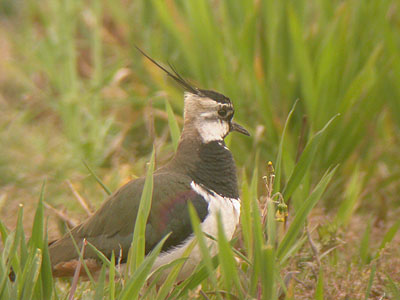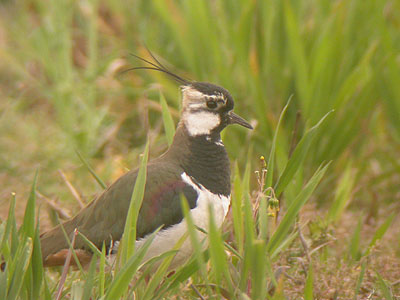

| Eakring Birds |
| The Lapwing at Eakring 1998-2007 |
| This page looks at yet
another of the most affected farmland species of recent
years. Lapwing have always been much more common during
the latter part of the Summer, when some post-breeding
flocks have occasionally produced counts well into three
figures. Breeding populations have remained
low since 1998 and their success rate has appeared to be
poor. Lapwing have been erratic as a successful breeding bird and it is not unknown for no birds to be present some years. Through the lack of any permanent breeding habitat, Lapwing seem forced to adopt an opportunistic approach to nesting and pairs are entirely dependent on the correct habitat being available for any breeding success. Suitable breeding habitat in the Eakring and Kersall area, has usually involved large areas of set-aside, but they seemed to be specific to certain types of set-aside. |
 |
|
| .... | ||
| Back in 2000, I looked at the different types of set-aside available here, and the plant/bird diversity that each held or attracted. Four types of set-aside were found, of which just two (types A and C) proved attractive to Lapwing as suitable breeding habitat. | ||
| Type A .... set-aside from former
cereal crop, sprayed the previous Autumn |
||
| This was (unfortunately) the commonest example of set-aside found. Spraying of herbicide after harvesting the previous Autumn, reduced to a huge extent the variation of plants growing in the same field the following year. | ||
| Type B .... set-aside from former
cereal crop not sprayed by herbicide |
||
| This was the second commonest set-aside. As expected, plant variety was greater. Non spraying allowed more biennial and perennial plants to become established amongst the self-sown cereal remaining from the previous year's crop. | ||
| Type C .... set-aside resulting from
former beet crop |
||
| Set-aside from a former beet crop was at first more sparsely vegetated than all three other types. This is largely due to the very late harvesting of beet and the fact that it's large, fleshy leaves prevent the germination of most other plants. Those that grow the following year are mostly annuals (quicker growing than beet, and able to compete for light before laying down seed again) and biennials (likewise, very quick to become established). The harvested fields remained bare until well into the Spring. When allowed to remain for a second year, the plant variety became the larger of all four types. | ||
| Type D .... one/three year old
set-aside from Kale crop |
||
| Just one small field of Kale was grown, situated east of and near to Eakring Flash. Presumably grown to aid the rearing of Pheasants, the field (as so often is the case where land is geared towards Pheasant rearing) became increasingly important for many species of birds, due to it's attractiveness as a food source resulting from growth of many seed-bearing plants during it's second year. By the end of 2000, the field remained unharvested and (thanks to the continued non-use of herbicides) a variety of mostly biennial and perennial plants became well established. | ||
| Breeding pair
numbers The number of Lapwing in the area by late February, has usually been a good indicator of that year's breeding pair population, but the annual variation in the number of breeding Lapwing at Eakring, has always been influenced by the availability of suitable habitat through crop types/growth and has been restricted here by large amounts of cereal and Oil-seed Rape production. Many breeding attempts since 1998 have resulted in failure, primarily due to nest destruction by modern farm machinery and pairs have been noted to make at least three attempts in the past, before eventually producing young. A method used to some effect in the past, has been the temporary "lifting" of nests ahead of cultivating machinery, before being moved back to their original location. More use of this lifting method over the coming years, is likely to be one of the key factors if Lapwing are to make any real, permanent comeback as a breeding bird here. |
 |
|
| .... | ||
| Out of 15
successful breeding pairs in the area since 1998, the
preferred nest sites of 14 of these were in type A and C
set-aside (predominantly open, bare or sparsely
vegetated) fields or germinating Sugar-Beet crops.
Clearly these particular type of set-aside created the
perfect breeding habitat which consisted of sparse
vegetation on bare soil. The field was large and hedged
all round. Quite often, male territories were within
close proximity and on several occasions, a single field
held much of that year's breeding birds. It can be
assumed that breeding Lapwing numbers will remain low
here because of a limited availability of preferred
nesting habitat. A more thorough summary of breeding populations and attempts, shows that in 1998 there were five pairs at two sites. No Lapwing bred in the area during the Summer of 1999, but a total of seven pairs nested in a single field on the Leyfields estate in 2000. The field had been used the previous year for Sugar Beet and was left as set-aside during the first part of 2000, before being sprayed in late May. By then, all pairs had produced young. A single unpaired male was also present throughout the Spring, often seen commuting to and from the area in an unsuccessful attempt to attract a mate. 2001 saw a halt to the increase of the previous year, with just four pairs present. Lapwing failed to breed successfully in 2002, despite four pairs attempting in both Bean and Sugar-beet fields and there were five pairs in the area during 2003. A blank breeding season in 2004 was followed the following year by six pairs in terriories around Eakring Field Farm/Park Farm and Red Hill in 2005. 2006 was yet another poor year and there was just one un-paired male holding territory in the Church Hill area. In 2007 things were better with six pairs breeding in fields at Park Farm. Summary Lapwing have always struggled to breed in numbers here. It might have been thought that with fields being much larger now than they were 40 or 50 years ago, breeding Lapwing might have fared much better. Modern farming practices have clearly had a considerably adverse affect on numbers and it is difficult to imagine any return to their former status. With the recent relaxation in the laws regarding set-aside, many farmers may well begin to crop land currently used as set-aside strips. Fields of set-aside have proved helpful to breeding success in the past ten years, but farmers are unlikely to continue with the practice now that government subsidies have ceased. A return to the old method of field cultivation in the Autumn, followed by the sowing of cereal crops in the Spring, would no doubt help Lapwing numbers, but unfortunately this will never happen. Over the next few years, I expect that the Lapwing will continue to be a scarce and irregular breeding bird at Eakring. |
||